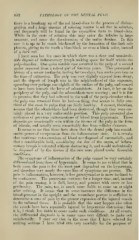Page 842 - My FlipBook
P. 842
852 PATHOLOGY OF THE DENTAL PULP.
there is a breaking up of the red blood-discs in the process of disinte-
gration, and a krge amount of coloring matter is set free in solution,
and frequently will be found in the crystalline form in blood-clots.
While in the state of solution this may enter the tubules in large
amounts, and cause the discoloration of the entire dentine. In this
case it is apt to be much blackened by the formation of the dark sul-
phurets, giving to the tooth a blue-black or even a black color, instead
of a dark red.
I have seen but few cases in which there was a clear and unmistak-
able deposit of inflammatory lymph making space for itself within the
pulp-chamber. One quite notable case occurred in the pulp of a second
molar removed from a robust girl of fourteen years. This presented a
history of a severe toothache, lasting for two days, two weeks previous to
the time of extraction. The pulp was very slightly exposed from decay,
and the deposit of lymph was in the neighborhood of this exposure,
spreading over perhaps one-eighth of the surface of the pulp, and seemed
to have been beneath the layer of odontoblasts. At least, it lay on the
periphery of the pulp, and the odontoblasts were wanting ; and it is fair
to presume that they had adhered to the wall of the pulp-chamber when
the pulp was removed from its bed—a thing that occurs in fully one-
third of the cases in pulps that are fairly healthy. I cannot, therefore,
assume that the odontoblasts had been destroyed, though they were cer-
tainly placed in a very unfavorable position. This pulp presented also
evidences of previous extravasations of blood from hypersemia. These
deposits are occasionally seen within the tissues of the pulp in the form
of islands, and usually seem remarkably free from cellular elements.
It seems to me that these facts show that the dental pulp has consid-
erable power of recuperation from the inflammatory state. It is certain
that moderate extravasations of blood are disposed of successfully, and
that a considerable bulk, considering the size of the organ, of inflam-
matory lymph is tolerated without destroying it, and would undoubtedly
be disposed of by the tissues if the case were placed under favorable
conditions.
The symptoms of inflammation of the pulp cannot be very certainly
differentiated from those of hypersemia. It seems to me evident that in
both cases the pain is for the most part dependent on the hypersemia,
and therefore very nearly the same line of symptoms are present. The
pain in inflammation, however, is less paroxysmal or is more inclined to
be continuous. The paroxysms continue for a longer time, and, instead
of the pain ceasing, it is dull, heavy, and persists with more or less
pertinacity. The pain, too, is much more liable to come on at night
after retiring. It seems that in some instances the difference in the
blood-pressure in the upright and the recumbent posture is sufficient to
determine a state of pain by the greater expansion of the injured vessels
in the inflamed tissue. It is probable that this may happen also when
the vessels have been repeatedly injured by hypersemic distension ; but
it is, I think, less liable to occur under such conditions. At all events,
the differential diagnosis is in many cases very difficult to make out
satisfactorily. I may say that in the cases that I have selected for
making sections I have tried this very carefully for the purpose of


